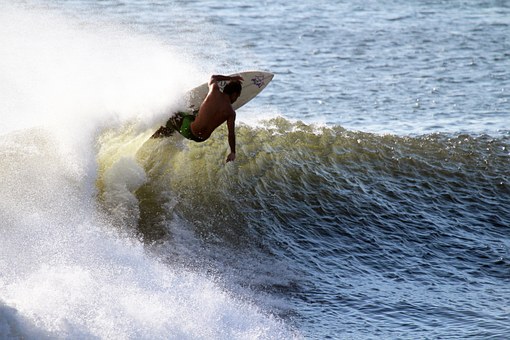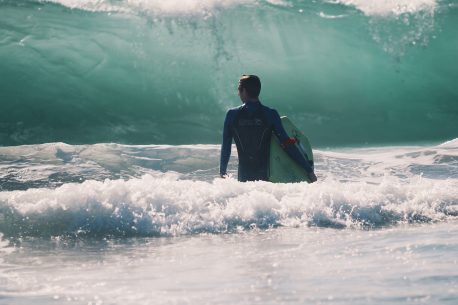

If the word atoll brings to mind images of the Maldives, it may be a surprise to discover that most of the 400 atolls in the world are located in the Pacific. Fly with us to Tuamotu to discover all the best surf spots in Polynesia!
Tuamotu, which covers a territory as large as Western Europe, is 1800km long, 600km wide: it is undoubtedly the main group with 78 islands, of which 77 are atolls, with the exception of Makatea, a coral island emerged. These islands are also called “The Labyrinth or The Archipelago of the Rough Sea” and are unrelated due to the difficulty of navigating the local waters. The exotic appearance of these atolls is linked to the palm tree which only been growing from 1860.
Mururoa and Fangataufa was the site of the infamous nuclear testing program run by the French Government in the SE corner of Tuamotu’s. On the east side there are the younger atolls, but it is the older atolls that contain reef pass, towards the inner lagoon. Out of the 77 atolls, only 32 have at least one pass (only 10 have numerous); and most of them are found in the NW corner of the territory.
The main atoll is Rangiroa, 75km in length, making it the second largest atoll after Kwajalein in Micronesia. Passage is a crucial resource for transportation, fishing and now, surfing. It is said that the first surfers arrived on a sailboat from Tahiti in the 1980s. Compared to the areas of large boat trips such as Mentawai or the Maldives, Tuamotu has more rough seas and the distance between the various spots is higher, so that a fast and luxurious boat is essential to reach the spots in a short and comfortable way. Although most of the spots work with swells from north, there are also some spots exposed to the SW that work quite constantly. Most N swells are clean, medium-sized, and usually right-handed; S swells on the other hand generally produce more intense lefts. Usually the spots are also suitable for less experienced surfers, as each spot has an inside zone where the waves break with less power than the bowl. It should be known that in Rangiroa the current in the channel reaches an average of 5km / h and flows into the lagoon 35% of the time, while the current flowing out is 55%. Although the reef passes are the main spots, it is also possible to surf the fake channels, the corners of the reefs, which are less exposed to gusts of SE winds. This is probably the last important frontier for boat travel; we hope boat operators in the area will help preserve this exceptional ocean environment.
The Crossing was first shown in 1999 scoring epic swells and later in 2002 top surfers hit Tuamotu and the Super Trip in Surfing was released in 2002. Archipels of Moorea made the first commercial surf vessel in years ’90. Wave hunters launched the Cascade in 2002 along with the Thaitian Bluwater Dream involving Australian Chris O’Callanghan, who is the competition director of the Teahupoo Pro and Moana David, Veteas’ brother and head Moana Surf Tours.
Tariff per person, starting from:
| Departure | Double |
|---|---|
| From 1 January 2020 to 31 December 2020 | € 126 |
Notes
It is a great destination all year round although the northern swells provide a higher quality surf than the southern ones. The swell season from north starts from November and lasts until April; these swells are generated by giant low pressure systems in the North Pacific, arriving in Tuamotu 3-5 days later than in Hawaii. Despite the great distance they take, they come with great power, releasing waves from 3-6ft up to 8-10ft. These waves last about 2-3 days. The S swell season lasts most of the year, peaking in the months of May-September, but it is not uncommon to have them shortly before or after the N season. They can range from SW to SE, and can last for many days. 3-6ft of swell are common as well as 8-10ft. Larger swells, up to 20ft, have occurred in past seasons with great infrequency. Like all South Pacific Islands, surfing can get very hit and miss. As the islands are flat and located just above the anticyclonic belt, the E-SE winds can be very strong, January-March are the months with the weakest winds while July-September the windiest. The tides can vary by 1ft max but the strong currents in and out of the reef channels can alter the depth of the water.
How to get there : Book a flight from Papeete (PPT) with Air NZ, Air Thaiti Nui from LAX or Hawaiian from Honolulu, or Air France from Paris.
Getting around : DIY transport is not the only option as reef passes aren’t close to piers and airports. Book a trip with the boat “ The Cascade”.
Accommodation and Food : Rangiroa is the most visited atoll, followed by Manihi, Tikehau and Pakarava. Ground-based accommodation is useless. An overnight stay in the Cascade is like a 4-star hotel with all modern facilities, 3 meals a day and free Hinano beer. Expect lots of fish and French cuisine.
Climate: There is less difference between the rainy and dry seasons than in Thaiti as there are no mountains that gather the clouds. There is more rain in the austral summer which causes short but heavy thunderstorms which decrease in winter. It is hot all year round but the period between May and October is the coolest (minimum 21 ° C in August) and the driest. There are more than 3000 hr of sunshine annually. Tuamotu relies on rain for its water supply, so don’t waste it. The water temperatures are 27 degrees and only a light neoprene wetsuit is needed to protect you from reef cuts and gusty winds.
Nature and Culture : We are in the middle of an immense ocean. Fishing rod and canoe aboard the Cascade. Pearl (black) industries and fish traps are the main economy.
Dangers and annoyances : Sharks are everywhere. Communication via telephone is possible but it costs $ 5 per minute.
Tips : Among the recommended quiver there should be 4 boards, from 6’5 “up to 7’4” with pin tails and gun-like shapes. Bring limestone for the reef, a helmet, a repair kit, tropical wax and shorts.
Exchange rate 1 EUR = 1.08 USD; 1 € = 1.51 NZD; 1 EUR = 1.41 AUD
Exchange rate variations (more than 3%) will lead to an adjustment of costs. They will be communicated within 20 days of departure.
The tariff does not include

Billabong Pro Teahupoo is an ASP World Tour professional surf competition held annually in Teahupo’o, a village on the southwestern coast of the island of Tahiti in French Polynesia. The reef is located in Teahupo’o and is a rewarding and important place for any enthusiastic surfer. The event in question was founded in 1999 and […]